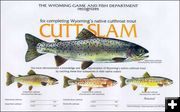

Cutt-Slam
Poster for the Wyoming Cutt-Slam program. Courtesy Wyoming Game & Fish Department.
|
|
Try for the Cutt-Slam this Fall
Catch Wyoming's four cutthroat sub-species in their native range in Wyoming
by Wyoming Game & Fish
November 8, 2011
Late fall often provides some of the best fishing of the year and hunters with late season licenses might consider adding another activity and pursue their Cutt-Slam certificate.
It’s always a good idea to throw in a fishing rod when heading out on a hunting trip as the fishing is usually very good and many hunt areas in Wyoming are close to productive waters. In many parts of the state, hunting trips are also taking place in areas close to waters that contain one or more of Wyoming’s four cutthroat subspecies.
Catching all four of the cutthroat subspecies in their native range qualifies anangler for the Cutt-Slam recognition. The program was started 15 years ago and since that time, 878 Anglers have received their Cutt-Slam certificate.
Probably the most difficult task to completing the Slam is just getting to the waters where the various fish are located. Substantial driving is usually involved to get to native waters of the cutthroat trout, unless you live in western Wyoming. The fish are usually not that difficult to catch and even if all species are not caught during the course of the trip, there is no time period in which the Cutt-Slam must be completed. Some anglers have stretched out their Cutt-Slam over five years or more, while others have caught their required fish in two days.
A key component of the Cutt-Slam is that all of the subspecies must be caught in their native range. Over the years, there have been numerous stockings of cutthroats outside of their native waters. While cutthroats caught in these waters provide diverse fishing opportunities, they do not count towards completion of the Cutt-Slam. As an example, a number of waters in the North Platte River drainage have cutthroats, but those waters are not the native range of any of the subspecies, so any of the fish caught in those locales do not count towards the Cutt-Slam.
In general, most of the native ranges of the various cutthroat subspecies are found in the western half of the state. The easternmost fisheries that are native range include the Bighorn River drainage for Yellowstone cutthroat and those are mostly located in the Bighorn National Forest. In addition, most of the waters in Yellowstone and perimeter areas around Yellowstone National Park have Yellowstone cutthroat trout. Other Wyoming waters where cutthroat are native are some of the small streams found in Southern Wyoming in the Sierra Madre Range of the Medicine Bow National Forest. The Colorado River cutthroat is the species in this location. In the western part of the state, Colorado River cutthroats are also found in the Green River Drainage. Many of the streams around the towns of LaBarge, Big Piney, and Pinedale have Colorado River Cutthroat. Other subspecies include the Bonneville Cutthroat found in the extreme western part of the state in the Bear River drainage. And finally, the Snake River cutthroat is found in numerous waters in the Snake River drainage.
Typically the Wyoming Game and Fish Department receives most completed Cutt-Slam entries in late summer and fall following the spring runoff as anglers take advantage of improved fishing conditions. But many anglers have completed their Slam by catching several species in the fall and finishing it off in the summer months the next year.
The Game and Fish website http://gf.state.wy.us has maps listing the various drainages where these fish can be found and also lists the requirements to participate in the Cutt-Slam. Anglers wanting more specifics on the Cutt-Slam and exact waters where the four cutthroat subspecies are found can call the Game and Fish at 307-777-4600.
|
